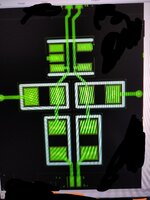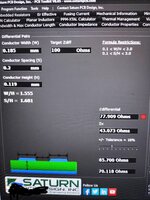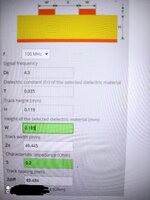Rajinder1268
Full Member level 3
Hi all,
I have attached a tracking layout for USB 2.0 layout. I need some advice on how I can better this. So it comes from the USB connector, through a ESD clamp, through R C for signal integrity / termination them to the USB to UART device.
My questions:
1. I need to keep the tracking the same i.e. in parallel with a gap of 0.2mm and 0.2mm track width. I am struggling to get this.
2. Also I am getting different results from USB impedance calculator. (See attached)
3. If we run at 480Mbps, will I have any issues with the current tracking?
4. I have right angles going into the clamp IC, i know it is not ideal but what is a workaround?
Thanks in advance
Here are the impedance calculator results.
I have attached a tracking layout for USB 2.0 layout. I need some advice on how I can better this. So it comes from the USB connector, through a ESD clamp, through R C for signal integrity / termination them to the USB to UART device.
My questions:
1. I need to keep the tracking the same i.e. in parallel with a gap of 0.2mm and 0.2mm track width. I am struggling to get this.
2. Also I am getting different results from USB impedance calculator. (See attached)
3. If we run at 480Mbps, will I have any issues with the current tracking?
4. I have right angles going into the clamp IC, i know it is not ideal but what is a workaround?
Thanks in advance
--- Updated ---
Here are the impedance calculator results.


